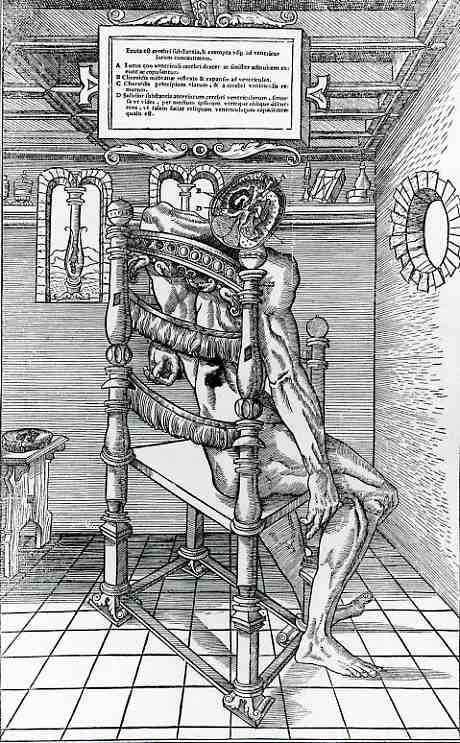JF Ptak Science Books LLC Post 441

This remarkable woodcut image comes from Charles Estienne's (1501-1564) De Dissectione Partium corporis Humani linri tres, a 375-page opus illustrated with 62 fantastic full-page woodcuts and published in 1545 This work is surpassed I think only by the masterpiece Fabrica by Vesalius (1543)--the great standard of anatomical illustration. Actually, historians have determined that the Estienne book was about ready to go in 1539, but due to a variety of problems, was not published until two years following his fellow-classmate's Vesalius' work. Had things gone a little differently for Estienne, he would most certainly enjoy more ethereal fame than he does now, though I'm sure some of that would be diminished by the weird and exotic nature of many of his prints. Vesalius chose a somewhat more pragmatic approach, though just about everyone would seem so compared to Estienne. The Estienne work comes at the beginning of the wave of spectacularly illustrated early books: Gesner's 1553 Historiae animalium, Georg Agricola's De re meteallica (1556), Pierre Belon's two works on fishes (1555) and birds (1556), Jacques Dalechamps (1513-1588). Chirurgie Françoise... avec plusiers figures des instrumens necessaries pour l'operation manuelle.(1569).and Matteo Realdo Columbo's (ca 1510-1559). De re anatomica libri XV (1559). are notable examples of defining-efforts of this period, classics of thought to this day. And beautiful.
The beautiful mind here in Estienne's effort is perhaps the most lovely of all of his illustrations--it is also the most unusual, and the most perspective-abusing. Our subject is seated in a seemingly-normal armchair of the period, except that the posts lack arms. The perspective is such that the chair back seems to alternate position, an apparent illusion, changing from front-to-back and back-to-front, while the chair back posts seem to also alternate heights. Nothing else seems to quite work either: the floor is at odds with the walls and ceiling, the window is falling inwards, and the chair (again) seems to float when you look at the ceiling.
Be that as it may, the dissection of the brain takes place with the cadaver in the chair, the body held there with pins (one of which is seen coming through the right shoulder. The four elements of the brain identified A to D are explained in the ornamental legend at top. We can see the rest of the top of the head placed on the stool at left, just in case anyone was wondering.
Again, the Estienne book was a magnificent and somewhat twisty-unusual accomplishment. Had he published in 1539, which was a definite "maybe", it would be Estienne who would've been known for introducing such things as the first time the entire human body was discussed and illustrated, and the first time that a serial dissection was presented and illustrated. But he didn't get the job done in '39, and so he is not known for these things. But almost.
Something happened to Estienne in 1561: after he had been appointed printer to the king of France, things went badly, and he went into bankruptcy, evidently dying in debtors prison in 1564. fine, old, principled and somewhat-monied family or not, Estienne didn't last long in incarceration.
Estienne's other works include:
- Praedium Rusticum (1554), a collection of tracts which he had compiled from ancient writers on various branches of agriculture and which continued to be a favorite book down to the end of the 17th century
- Dictionarium historicum ad policum (1553), the first French encyclopedia.
- Thesaurus Ciceronianus (1557)



Comments